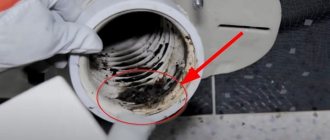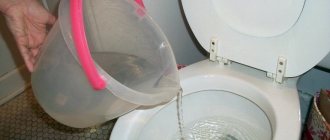Most owners of private houses are faced with an unpleasant odor in their rooms. You will need to know why the sewer smells and how to properly fix the problem with your own hands. There are many options for how to get rid of unpleasant odors in a private home.
ATTENTION! A unique, highly effective product has been developed for cleaning sewer pipes, eliminating any blockages. The product is a concentrated mixture of enzymes that easily break down and process fat accumulations and any deposits of organic origin. One package of Saniclean will last you a whole year! Read more"
Causes
Unpleasant sewer odor can occur due to many problems. It is recommended to carefully inspect the entire system to understand the reason. It is possible that such an examination will not bring positive results.
The following are the causes of unpleasant odor:
- There is no special fan ventilation, which is necessary for purging the sewerage. It may be incorrectly installed or broken. You will need to contact specialists who deal with this.
- Mistakes that craftsmen made when installing sewer systems. They may have miscalculated the height difference between the plumbing and the septic tank. This can result in a strong sewer smell in your home. In such a situation, it will be necessary to rebuild and re-equip communications.
- Cracks and various damage to elements of the sewerage system. This is dangerous because liquid may leak or drip from the pipes. The equipment will need to be repaired for the smell to go away.
- The water seal has dried out. If a drain is connected to the sink or bathtub and has not been used for a long time, then this problem may appear. You just need to turn on the water and the smell will go away on its own.
- There was a difference in atmospheric pressure. An unpleasant odor may appear due to the fact that the sewer system is not designed correctly or is broken.
- Blockages. The most common cause of drain odors is clogged pipes.
You will need to eliminate the cause of the smell in the sewer. There may be several of them, so it’s best to call a professional or try to remove the stench with your own hands. It is best to carefully look at all outlets, sinks and toilets. If the cause of the unpleasant odor has been found, it must be eliminated.
Autonomous sewage system
Individual sewerage in a private house is designed to drain fecal and gray water after cleaning, during the use of sanitary appliances, washing machines and dishwashers.
Typically, wastewater enters a septic tank, where, after settling, it is sent to aeration fields or drainage wells.
When people live in a house for a short period of a year, instead of a standard septic tank with a multi-chamber sedimentation system, a storage tank is sometimes used, which is periodically emptied with a sewer truck.
Any autonomous sewer system can be divided into the following units:
Central riser. This is a large diameter vertical pipe made of gray PVC polyvinyl chloride, usually with a diameter of 110 mm, into which domestic wastewater is collected. A typical riser runs through all floors, its extreme points being the pipe ends in the attic and basement. Unlike apartments, an autonomous sewer riser is often placed outside near the wall of a building.
At the bottom, the riser turns into a horizontal pipe section, which goes with some slope into the septic tank, and at the top it is closed with a drain pipe.
Rice. 2 Examples of connecting plumbing fixtures to the sewer
Pipelines from plumbing fixtures. Kitchen sinks, bathroom sinks, bathtubs and showers themselves, toilets - all these plumbing fixtures are connected to the central sewer riser through pipes laid with a certain slope. The standard internal sewer pipeline in a house has a diameter of 50 mm; a corrugated pipe of about 110 mm in circumference usually extends from the toilet.
Each pipeline leaving the plumbing fixtures is equipped with a curved hydraulic valve; in the toilet it is implemented in the bowl itself.
Fan pipe. The riser going into the attic of a private house must be connected to the ventilation system; the transition element connecting these nodes is called a vent pipe.
Fan pipes come in a wide variety of models; they can have a straight shape, a shape curved at various angles, or a corrugated shell. This is due to the fact that the ends of the riser and ventilation pipes are often located at different distances and can be shifted along the axis relative to each other.
The dimensions of the vent pipes are maintained in such a way that they fit tightly onto a riser with an outer diameter of 110 mm and are inserted at the other end into the ventilation pipe, the width of the passage channel of which varies depending on the manufacturer.
It should be noted that although the vast majority of owners of individual residential buildings install a drain pipe with exhaust ventilation, these elements are not mandatory; they can easily be replaced by a vacuum valve. The element is placed on the end of the riser; it automatically supplies air to the pipeline when using the sewer system and closes the channel when there is no drainage.
Horizontal pipeline. A pipe with a similar diameter of 110 mm departs from the lowermost part of the in-house riser, which is sent through the basement to the outside of the house; to connect the two sections, bends with angles of 90, 60 or 45 degrees are used.
Since the pipeline is laid outside, a heat-resistant, durable pipe is used from a different type of material - red-colored unplasticized PVC-U polyvinyl chloride. The external sewer line is laid with a slope of about 20 mm per linear meter and is directed to the septic tank; in order to avoid the accumulation of gases, the latter is equipped with an exhaust hood.
Rice. 3 Connection of fan pipes with hood
Related article:
Connecting a bathtub to a sewer system - types of siphons, connection options, installation. If you are reading about how to eliminate the smell in the sewer in a private house and perhaps you will change the bathroom, and how to connect it to the sewer, read in a separate article.
Odor danger
Sewer smell is dangerous to human health. Few people know about this, since many people think that the stench is simply unpleasant. Gas fills the cavity of the pipes and enters the house through a siphon. The smell can cause severe harm to a person if it penetrates into an apartment in large quantities.
Drain stench can be dangerous due to the following components:
- Methane. It does not lead to serious poisoning as it causes a chronic condition. If you constantly inhale it, you will experience headaches and arrhythmia. The main danger of methane is that it can ignite or explode.
- Carbon dioxide. It is much heavier than air, so it enters the apartment in small quantities. Carbon dioxide is harmful to animals and humans. When people sleep, it enters the lungs, causing severe fatigue and weakness.
- Hydrogen sulfide. It is very toxic and affects the human central nervous system. The component reduces sensitivity to odor. After a while, a person stops feeling the smell in the air.
- Hydrogen. It is not dangerous in itself. It is best that there is no sewer smell in the apartment.
It is recommended to get rid of the problem immediately to avoid serious health problems. An unpleasant odor begins to accumulate in the apartment, and the components begin to destroy the human nervous system.
How to eliminate the smell in the sewer in a private house
The solution to the problem of how to get rid of sewerage smell in a private house is directly related to the type of reason that caused its appearance; often the owner manages to cope with the problem on his own; in case of failure, the help of employees of specialized companies will be required.
Elimination of leaks
Leaks can appear due to damage to the pipeline or a violation of the tightness of the joints; the problem can be solved in two ways - by sealing the leakage area or replacing the pipe.
It should be noted that in domestic sewerage there is practically no pressure and liquid waste is transported by gravity, therefore, no high demands are placed on any sealing materials on the surface of the pipes in terms of the strength of their structure and the connection itself.
Repairing the defective area
If a crack or fistula appears in a PVC pipe, the defective area is sealed using one of the following methods:
- For a small fistula, which often appears in pipes as a result of an accidental drilling of the pipeline during repair work, the hole can be sealed with cold welding or epoxy resin.
- If the hole is large, apply a patch of rubber or other sealed soft material, gluing it to the pipe.
Rice. 8 Sealing holes in the sewer pipeline with improvised means
- For reliability, the entire pipe is wrapped in material, for example, a bandage is used, which is then covered with epoxy resin. The pipe can also be wrapped with adhesive tape or electrical tape; the latter is best used on a black fabric base due to its higher stretch coefficient, which allows you to wrap the damaged area tightly and with good tension. If you don’t have fabric tape on hand, a medical adhesive plaster, which has excellent adhesiveness and high extensibility, is a good substitute.
- If a crack has formed in a PVC pipe, it is better to repair it with a patch made from a piece of rubber, attaching it to the surface of the pipe using electrical tape or tape.
- If there is a long crack, it can be closed with a piece of any porous sealed material (rubber, polyethylene foam) and pressed on top with a rigid segment of a cut sewer pipe - this will create uniform pressing force and, accordingly, a high degree of sealing of the defect along the entire length.
- It is a good idea to fix the overlay fragment of the PVC pipe with clamps - this will provide a much higher degree of pressure than electrical tape or tape.
- The most reliable, aesthetic and correct way to seal cracks in a pipe is to use factory-made overhead clamps with sealing gaskets. They are a single thin clamp or products made from two rigid fragments, which are fixed and pressed to the surface of the pipe with nuts and bolts.
Rice. 9 Options for eliminating leaks with overhead clamps
Pipe replacement
If a leak occurs at the junction of two pipes, one of the main reasons is damage to the rubber sealing ring or its loss of its plastic physical characteristics. In this case, the leak is quite difficult to eliminate using the above methods and the pipe may need to be replaced.
When it is possible to disassemble a sewer section with a damaged pipe without high labor costs, the problem of replacing the pipe does not pose any particular difficulties. Even if the pipe was purchased from another manufacturer, its outer diameter of 110 mm and a similar inner diameter of the connecting socket have an unchanged rating with slight deviations that do not affect the tightness of the joint.
The situation is different if it is impossible to dismantle the section with the damaged pipe. In this case, the way out is to use an additional repair coupling in addition to the pipe. The essence of this method of installing any pipe section into a line section is that the coupling has a long socket and can move along the pipe for some distance.
Before installation, the assembly is prepared for replacement: a new pipe is cut and inserted into the coupling until it stops, so that the length of the connected parts corresponds to the free opening. Next, the pipe of the assembled unit is inserted into the socket of the pipeline on one side, and the coupling is pushed onto the pipeline from the other end, thus obtaining a sealed connection.
Rice. 10 Technology for inserting a tee into a pipeline section using a repair coupling with an extended socket
Correcting installation errors
Some of the main mistakes when installing sewer pipelines are failure to comply with the required slopes, incorrectly installed water seals, lack of cuffs at the points where drain hoses from household appliances enter the pipeline, lack of inspection in the right places (the main one is at the top point of the riser).
With small slopes, water will leave the sewer too slowly, polluting the clean water masses of the water seal in the toilet - this will lead to the appearance of odors in the bathroom or in the bathroom when plumbing is installed together.
Sometimes owners, when installing plumbing fixtures themselves, violate the horizontal plane of the water seals, and water simply does not stay in them - this causes sewer odors to appear in the apartment.
The owner himself can often eliminate installation errors; to do this, he will have to check the correct placement of water seals and the slopes of the sewer pipeline. In the latter case, you will need a building level at least 1 m long, which should be applied to the pipeline at one end and the size of the gap should be checked at a distance of 1 meter with a strictly horizontal position of the water bubble in the peephole.
If the verified slope of the pipe is less than 20 mm per linear meter, you will have to dismantle the entire system and lay communications with the required slope angles. This work can be carried out by both hired specialists and owners if they have special construction tools; usually a hammer drill is needed to destroy floors, walls and drill holes in them.
If there is a smell in the places where hoses from dishwashers and washing machines enter the sewer pipeline, purchase cuffs and O-rings that are more suitable in size from the retail chain and replace the old ones with them.
Rice. 11 Examples of placement of inspection pipes on the sewer main
Related article:
Sewer cleaning - methods, options, tools and means. A separate article describes in detail how to independently deal with sewerage blockages in a city apartment and private house. Read it, it might be interesting.
Restoring ventilation
If your apartment smells like sewage only when you use the toilet, one of the most likely reasons is a broken water seal.
Finding installation errors
In order to eliminate malfunctions that occurred during installation, you will need to understand how the sewer system works.
The toilet should be connected to the riser lower than all other fixtures in the bathroom. The outlet should have a diameter of 10 centimeters. The dimensions of other connections are at least 7 cm. If everything is installed correctly, there will be no blockages.
If there is little water flow in the bathroom, the sink is clogged, or there is an unpleasant smell in the kitchen that cannot be removed with a freshener, you need to act immediately. With the help of Saniclean you can easily cope with the situation without a plumber... Read more»
The sink is clogged
First let's run the water in the sink. If the water stagnates or leaves slowly, then a blockage has formed in the siphon, or in the socket, which is located between the washbasin and the siphon.
The blockage in the siphon is removed by disassembling the device and cleaning it with detergents. Next, you need to install the siphon in place and check the operation.
If the cause is not eliminated, then you need to use a special cable to clean the pipe.
Before using the cable, the sink is pumped using a plunger, which removes the plug and temporarily restores the flow of liquid. The plunger method is not radical.
Removing clogs in the sink.
If there is water in the sink, then you need to clean the siphon in the usual way. If the washbasin and sink are filled at the same time, it means that the blockage lies in the drain pipe common to these plumbing fixtures. A cable is used for cleaning.
Removing blockages in the bathroom.
The bathtub is prone to clogging with hair and animal hair that wrap around the drain grate.
You can remove the plug using a wire hook, after first removing the grille. Next, clean the pipe using a cable.
How to clear clogs in the toilet.
A clogged toilet in a private home is considered a serious problem.
And the siphon in the toilet passes the liquid into the riser, which has a larger cross-section than the drain pipe. As a rule, a clog in the toilet is caused by a rag. The drainage from the riser goes back into the toilet, and with it the odors.
To remove such a plug, it is better to call specialists.
How to get rid of blockages
If the sewer is clogged, a stench will appear in a private home. When debris accumulates in the siphon, it is dismantled and cleaned. If the pipes are clogged, then mechanical methods and chemicals must be used. You can try to remove the blockage with a plunger, which will help push out all the dirt. The steel cable will be able to break small pieces of debris into pieces so that they can then be easily washed away.
If you choose chemicals, you should look at the material of the pipes. It is recommended to clean cast iron with various gels. These products contain acids and alkalis. The packaging will tell you how to use the chemicals correctly so as not to harm the pipes.
Preventive measures
Typically, residents of private houses connect sewer structures directly to cesspools. There are three types:
- without bottom;
- sealed;
- septic tank
Not a single pit from the above is immune from silting up and serving as a source of stench. You can clean the structure by various means: with a bucket on a long rope, using a drainage pump, a suction pump equipped with special machines, as well as using sanitary bio-cleaning and chemicals for home cesspools.
Of course, it is safer and more beneficial to use biological products. These can be special powders, tablets or liquid products, but they have a small disadvantage. The composition of bioactivators includes microorganisms that multiply well during the warm period; in winter, the microbes do not work at full strength and do not remove the smell.
Among chemical agents, the best option is all nitrate oxidizers. Ammonium salts and formaldehyde are highly toxic to humans and animals, so it is best not to use them in this situation.
If, after pumping out sewage from the pit and cleaning it, it still stinks, then look for the problem elsewhere. Let us remind you that an obsessive stench can be provoked, for example:
- a drain pipe that was installed in violation of the standards;
- clogged ventilation duct or improperly equipped ventilation system, lack of an exhaust fan;
- clogged sink hole;
- poor cleaning of the siphon or drain.
Problems with the water seal
In order to create a water seal, you need to take a curved pipe so that its elbow is below the drain level. A barrier with tap water is installed in it, which will not allow the stench to pass through. When liquid flows through the pipes, it will be replaced by water.
Problems in the system can happen due to:
- Cracks in the siphon.
- A water plug that is drawn into the sewer.
- Rare use of the system.
If the fluid in the knee dries out, it is recommended to open the tap to restore the fluid level. When damage appears in the channels or siphon, it is necessary to lubricate it with sealant.
Causes of unpleasant smell from sewerage
The sewer system of any home is designed to remove various sewage: human waste products, dirty water after washing, washing dishes, and wet cleaning. The remains of spoiled food are sometimes flushed down the toilet.
The process of waste decomposition occurs with the help of putrefactive bacteria, and a significant amount of hydrogen sulfide is released. This foul-smelling gas comes from sewer pipes.
You should not put off eliminating this problem for too long - upholstered furniture, carpets, curtains or other home textiles quickly absorb all kinds of odors, accumulate them, and then it is difficult to get rid of the barely noticeable but persistent stench. Hydrogen sulfide, methane, and mold released into the air can cause allergic reactions in households, attacks of bronchial asthma, and, in high concentrations, poisoning.
To effectively eliminate a specific smell from the sewer system in an apartment, you need to find its source. The main causes of stench:
- clogged pipes and siphons;
- lack of a water seal;
- ventilation system problems;
- presence of hidden leaks;
- improper installation of plumbing structures.
Problem in the ventilation system
If there is a sewer smell because the ventilation system is faulty, there is a simple action you need to take. You will need to attach a piece of paper to the hole. If it falls, the ventilation has stopped working. In such a situation, all pipes will need to be thoroughly cleaned. If ventilation is very poor, then experts advise installing a forced-air system to purify the air. To do this, a special fan is installed in the hole. It works well to clear the air of sewer stench.
Removing odor caused by clogs
Sewage smell in an apartment often occurs when a blockage forms in the pipes. In this case, there is only one way out - cleaning the pipes. To prevent this problem from occurring, it is necessary to use plumbing fixtures correctly. All family members, even children, should know that newspapers, rags, vegetable peelings and other garbage should not be flushed down the drain. To avoid blockages, it is recommended to install protective nets on the drain holes in the bathtub and sinks, which will trap various debris, including hair, which is often the cause of severe contamination of pipes.
Repairing small cracks
Pipes can leak at the joints. If the pipes have moved, they must be returned to their place. When rubber seals on plastic pipes break, they will need to be completely replaced with new ones.
In order to remove leaks in sewer channels, water is drained and dried. Next you will need to saw off a small piece of pipe of the same length and cut it lengthwise. Where a crack or tear has formed, it is necessary to anoint it with special glue. Next you should put the patch and press on it. If microcracks have formed in cast iron fixtures, then you will need to use cold welding.
Leaks in sewer pipes
It may stink due to leaks. It is not easy to detect them: pipes are usually hidden in boxes and covered with tiles. Therefore, plumbers advise to always provide access to utility systems using hatches, and also not to get carried away with fittings: corners, tees - leaks most often occur at the joints .
If a problem is found, it must be resolved. When there are plastic pipes in a country house, it is enough to replace the rubber seal . For reliability, it can be treated with silicone sealant.
If cast iron pipes were used during construction, you will have to tinker a little longer. Ideally, the problem area needs to be replaced, which will have to be done sooner or later. But as a temporary measure, you can do the following.
Prepare a piece of rubber and two clamps with a diameter equal to the diameter of the pipe. A rubber patch can be cut, for example, from a car tire. Its length should be equal to the circumference of the pipe, that is, encircle it entirely. You need to wrap the pipe in rubber, press it tightly to the metal and secure it with two clamps. This patch will help keep the crack dry until the plumber visits.
Pipes are frozen
A sewer smell may appear due to severe frosts outside. You will need to check for ice blockages. It happens that ice appears inside, so the opening narrows and the water drains much more slowly. It begins to stagnate there and eventually stinks throughout the entire apartment.
First of all, you need to find the area where the pipe is frozen. You can add hot water along with salt. To prevent the plug from appearing again, you will need to check whether the toilet tank or faucet is leaking. It is best to insulate the pipeline so that such unpleasant situations do not occur.
Clogged sewer - ways to get rid of it
Putrid smells often come from clogged siphons, but under certain conditions they can also come from other areas. If a slowdown in drainage is noticed, accompanied by a putrid spirit from the sink, a plug of dirt and grease has formed in the siphon, preventing the water from draining normally. The liquid stagnates, putrefactive bacteria quickly multiply in it, the waste products of which are gases that poison the air. There are several ways to get rid of a grease and dirt plug, depending on the degree of access to it.
If the siphon is accessible and made of plastic, the easiest way is to unscrew it, wash it with warm water and soap and put it back together. Cleaning will be 100%.
A less labor-intensive method is chemical: you can use industrial or home remedies. The method of using ready-made products is explained in the instructions for use. Please pay attention to the purposes for which the product is intended:
- preventive – for periodic use to prevent blockages;
- active – if it is noticed that the water has begun to drain more slowly;
- emergency – serious gaps are eliminated.
Please pay attention to the characteristics of the products: universal – for all occasions, fat-breaking – for the kitchen, hair-breaking – for the bath.
For home remedies, we use baking soda, citric acid, and vinegar. To prepare a working solution, take half a glass of soda or 2 packets of citric acid, dilute it with hot water, about 3 liters. Pour the liquid into the drain. You can use baking soda and vinegar. First, pour a glass of soda into the drain, and pour a glass of vinegar there. A violent reaction begins, corroding the fat. After use, rinse the system with water. Home remedies are suitable for the kitchen as preventive measures; they will not remove severe blockages.
Among the mechanical means we use a plunger and a plumbing cable. Cleaning with a plunger is very simple: place the plunger on the drain hole of the sink with water, press firmly several times and remove with a jerk. If the water drains quickly, the blockage has been removed. If not, we repeat the procedure.
If the plug has formed at a distance from the appliances, use a plumbing cable. We do the work together. First, we open access to the place of blockage, for example, remove the siphon or covers on the riser. We insert the cable into the pipe and begin to move deeper. Another person rotates the handle of the cable, winding various debris around the cable. If the end of the cable rests, we still move forward, destroying the blockage. After removing it, we flush the system.
Malfunctioning of apartment wiring
If the smell is felt only in places where hygiene devices are installed, it can be assumed that it is caused by defects in the apartment wiring.
If an unpleasant odor appears in the room, you should first inspect the wiring in the apartment, checking the tightness of the connections and the presence of hidden leaks
As a rule, a leak from a pipe is immediately visible, but other, less visually noticeable options are also possible, which include the options described below.
Result of hidden leaks
In sewer systems made of traditional cast iron or currently popular plastic, fistulas, cracks, and other defects may appear.
Since pipes are often walled up in walls or floors, it is quite difficult to identify and eliminate such defects. It is especially difficult to determine leaks in interfloor partitions with difficult access to the sewer system.
Leaks in the sewer system often become the source of an unpleasant odor. To eliminate it, you need to replace the damaged element or seal it with a special compound
Where an unpleasant odor appears, you should, as far as conditions allow, immediately check the pipes and the places where they come into contact with the plumbing. If necessary, you should call a specialist who will diagnose and professionally solve the problem.
Usually, to eliminate a leak, the system is replaced or sealed with modern materials or a cement mixture that does not contain sand (for cast iron pipes).
To prevent such defects, when installing apartment wiring, you must remember the following rules:
- when installing communications, use only high-quality pipes and fittings;
- carry out installation according to a scheme that provides for a minimum number of joints, since leaks most often occur in such units;
- when installing pipes, provide access to installed systems;
- take care of high-quality waterproofing of walls, floors in bathrooms, and in the kitchen.
Such measures will provide effective protection against leaks, and, if necessary, will allow the leak to be quickly eliminated.
Lack of tightness of the system
The appearance of a sewer smell in a bathroom or kitchen can also be caused by a leak in the pipes or when they are connected to a sink, sink, or other plumbing fixtures.
Particular care should be taken when connecting sewer pipes. To prevent the release of moisture and odors, joints should always be treated with sealant
It is important to carefully check the nodes connecting the devices to the sewer network, secure them, and then carefully treat them with sealant to eliminate minimal gaps and cracks. Often such a simple manipulation allows you to get rid of the smell of sewerage both in the bathrooms and throughout the apartment.
Incorrect operation of the washing machine
The reason for the specific “aroma” may be a familiar unit - an automatic washing machine.
With insufficient care, colonies of fungi and microorganisms can settle in the washing machine drum, causing unpleasant odors in the room
The odor may be caused by the following reasons:
- Incorrect connection of the device to the hydraulic valve, causing waste to enter the system. To fix it, it is better to disconnect the hose from the sewer, leading it to the toilet or sink.
- A clogged drain pump filter (most often it is located at the bottom of the machine). Sometimes, to eliminate an unpleasant odor, it is enough to clean this part.
- Plaque on the walls of the tank or tray for detergents, which is caused by the development of mold and other microorganisms on the surface. To eliminate them, it is important to regularly clean the components of the washing machine with disinfectants, vinegar, and citric acid.
To prevent a useful unit from poisoning the atmosphere with a stench, it is important to follow the rules for caring for this type of household appliance. It is advisable to periodically turn on a high-temperature washing mode, which allows you to get rid of harmful fungi and bacteria.
The best way to permanently get rid of the possibility of an unpleasant odor from the washing machine is to connect it to a bottle siphon under the sink in the kitchen or under the sink in the bathroom:
Image gallery
Photo from
Step 1: Preparing the washing machine hose for connection
Step 2: Location of Hose Outlet for Connection
Step 3: Connecting the drain hose to the siphon
Sealing ring for drainage
Microcracks in the drain of the sewer system
Another possible cause of unpleasant odors is microcracks or diaper rash that form in inaccessible places. They become sources of sewer “odors” and are very difficult to find and eliminate. Way out of this situation:
- replacing a damaged pipe with a new, better one;
- treating all suspicious areas with a sealant.
Connecting plumbing to the sewer
In order to prevent leaks from occurring in the future, and therefore the appearance of foreign odors from drainpipes, it is necessary:
- install high-quality plumbing pipes, only from trusted manufacturers (although they are not very cheap);
- when laying drainpipes, it is recommended to make as few joints as possible; cracks most often occur in these places;
- perform high-quality waterproofing of the floor and walls in the bathroom or toilet;
- place joints only in easily accessible places, although this is not always possible.
Restoring ventilation
If the apartment smells like sewage, and the sources of the problem have not been identified, it is quite possible that the reason for this lies in a malfunction of the ventilation system. Homes usually have a natural draft of ventilation.
To check the operation of the ventilation structure, a simple test is carried out - a sheet of paper is applied to the grille. With normal draft, it will be held by the air flow, in other words, it will simply “stick” to the grille. In the absence of ventilation, mold and mildew form on the walls, resulting in a slight but rather unpleasant odor. The problem of poor ventilation can be solved in the following ways:
- Clean clogged channels. This work must be performed by specialists. It will not be possible to cope with this task on your own, since poor ventilation is most likely associated not only with blockage near its entrance to the apartment, but throughout the house.
- Create forced ventilation by installing a fan in the existing duct. You can handle this work yourself.
There are many reasons why there is an unpleasant sewer smell in the house. In order to eliminate this problem, you must first determine its source. The appearance of an odor may be due to clogged drains, problems with siphons and “water locks,” as well as problems with leaking pipes in the basement. It is possible to cope with the appearance of an unpleasant stench only if the cause of the problem is discovered, and it can also lie in the apartment plumbing - clogged pipes in the bathtub, sink, shower stall. Some problems, such as cleaning pipes, can be dealt with on your own, but in other situations it is better to turn to plumbers if you do not have the necessary knowledge to replace pipes, fix leaks and solve other similar problems.











